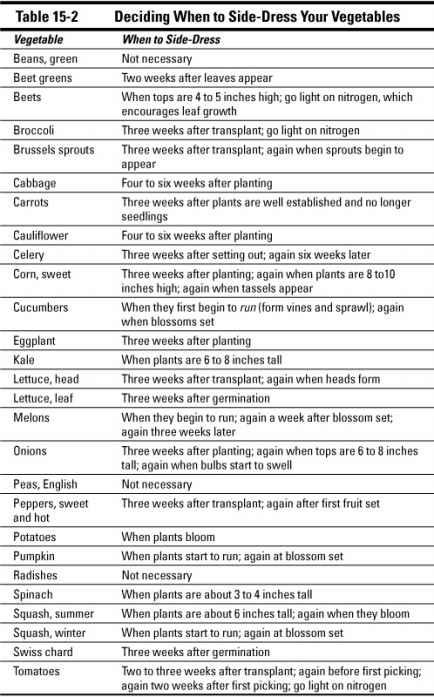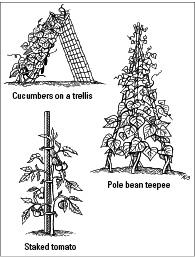Vegetable Gardening (111 page)

The kind of plants that you grow makes a difference in how often you side-dress. Plants that take a long time to mature (such as tomatoes and eggplants) and heavy feeders (like corn) generally benefit more from side-dressing than quick-maturing crops that fix their own nitrogen — such as lettuce, or legumes like peas and beans. See Table 15-2 for some general side-dressing guidelines.


Proceed carefully: Using wood ashes as a fertilizer
Wood ashes are a source of potash and phosphate, although the exact amounts of these nutrients depend on the type of wood burned (hardwoods generally contain more nutrients than softwoods), the degree of combustion, and where the wood was stored (for example, dry storage prevents nutrient leaching). A general analysis is usually in the range of 0 percent nitrogen, 1 to 2 percent phosphate, and 4 to 10 percent potash. But the major benefit of wood ashes is as a liming agent to raise the pH of the soil. Naturally, if you live in an area where soils are alkaline, don't use wood ashes as a soil amendment; they raise the pH even higher.
Apply wood ashes to your soil in moderation (no more than 10 to 20 pounds per 1,000 square feet of garden) because they may contain small amounts of heavy metals, such as cadmium and copper.
Remember:
These metals build up in plants if you add too much wood ash to the soil and can kill the plants — or harm you if you eat lots of those plants.

Give 'Em Something to Lean On: Supporting Your Vegetables
Some vegetables, like peas and beans, have climbing habits that require some type of support to grow on. Other vegetables — including tomatoes, cucumbers, and even melons — have sprawling habits that benefit from some type of staking or support. Staking plants, tying them to a trellis, or growing them inside wire cylinders reduces disease problems because it allows for better air circulation and keeps the fruits off the ground where they may be attacked by bugs or become sunburned. (Fruit skins get sunburned due to sudden exposure to strong sun and eventually rot.) Supported plants also are easier to harvest and require less space to grow (they go up instead of out).
Figure 15-7 shows some techniques for supporting vegetables, but you can find more in Chapter 16. In the following sections, I provide some suggestions for supporting different types of vegetables.
Beans and peas
Twining or clinging plants like beans and peas grow best when they're supported by some type of string trellis. I like to use an A-frame string trellis, which enables me to grow plants on both sides, but single poles are fine, too. Making an A-frame string trellis is easy; just follow these steps:
1. Using at least six 2-by-2-inch redwood or cedar stakes, build two 6-by-6-foot squares.
Figure 15-7:
Techniques for supporting vegetables.
Redwood and cedar stakes are naturally rot resistant and good choices.
2. Secure the corners of the squares with metal corner braces and connect the two squares on one side with sturdy hinges.
The hinges enable you to easily move or store the trellis.
3. Hammer small nails at 2- to 4-inch intervals along the top and bottom of the trellis.
Don't pound the nails in all the way; leave about 1 inch sticking out.
4. Weave some sturdy twine or string up and down the trellis, between the nails.
Bingo; you have an A-frame string trellis.
 Handmade wooden teepees are a great way to support your beans, and kids love them because they're great places to hide. Here's how to construct your own teepee:
Handmade wooden teepees are a great way to support your beans, and kids love them because they're great places to hide. Here's how to construct your own teepee:
1. Using four to six 2-by-2-inch redwood or cedar stakes that are 6 to 8 feet long, form a conelike teepee.
2. Tie the stakes together with twine at the top of the teepee.
3. Run some string or twine around the bottom of the teepee, securing the string or twine at each stake with a small nail.
4. Run more string back and forth around the stakes, from the top of the teepee to the bottom, leaving several inches between each run.
Leave one side of the teepee open so your kids can get inside, and then plant beans around the base of the teepee. In time, the beans will cover the trellis, creating a great fort for your kids.
Melons and cucumbers
You can plant bush varieties of melons and cucumbers inside small (2- to 3-foot-high) wire cylinders similar to those used for tomatoes (see the next section). But for more vigorous varieties, I like to use a sturdier version of the A-frame trellis that's used for beans and peas (see the previous section). Instead of using string, I cut 6-foot-by-6-foot pieces of hog fencing (it has 6-inch squares) and nail them to each side of the trellis. The wire provides better support for heavy fruit (like melons) than string does, and the wide-open fencing doesn't constrict the growth of the fruit (so you get straighter cucumbers). You can purchase hog fencing at agricultural stores.
 You also can grow melons on a trellis. Choose small-fruited varieties of watermelon or any variety of cantaloupe, and plant your seeds at the base of the trellis. Tie the vines to the trellis as they grow. After a fruit forms, slip the leg of an old nylon stocking over the fruit, tying the bottom of the stocking in a knot. Then tie the other end of the stocking to the wire trellis so that the fruit is supported. As the melon grows, the stocking expands and supports the fruit, which may break off otherwise. Flip to Chapter 8 to see how this support system looks.
You also can grow melons on a trellis. Choose small-fruited varieties of watermelon or any variety of cantaloupe, and plant your seeds at the base of the trellis. Tie the vines to the trellis as they grow. After a fruit forms, slip the leg of an old nylon stocking over the fruit, tying the bottom of the stocking in a knot. Then tie the other end of the stocking to the wire trellis so that the fruit is supported. As the melon grows, the stocking expands and supports the fruit, which may break off otherwise. Flip to Chapter 8 to see how this support system looks.
Tomatoes
You can support tomato plants several different ways:
 Tie them to stakes, which you pound in the ground next to the plants.
Tie them to stakes, which you pound in the ground next to the plants.
 Grow them inside wire cages, which you can buy at nurseries or easily build yourself out of hog fencing.
Grow them inside wire cages, which you can buy at nurseries or easily build yourself out of hog fencing.

